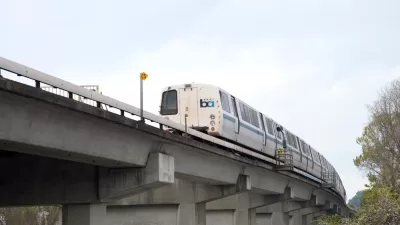In December, Sen. Dianne Feinstein reactivated her call for a southern crossing over the Bay while the BART Board last week began studying a second Transbay tube. The San Francisco Chronicle editorial board opines on which is preferable.

California's senior U.S. senator, Dianne Feinstein, and Rep. Mark DeSaulnier, (D-Concord) have asked the San Francisco Bay Area's transportation agency, the Metropolitan Transportation Commission, to consider a bridge option to provide relief for transbay travelers between the East Bay and West Bay, which includes San Francisco. Meanwhile, the Bay Area Rapid Transit (BART) District board began planning for a second transbay tube which could possibly include standard gauge tracks to carry commuter and intercity trains.
It boils down to a modal competition, as one would accommodate primarily motorists, and the other BART passengers and potentially passengers on other rail lines.
"One makes sense and the other should be tossed," opines the editorial board of the San Francisco Chronicle on Feb. 22.
BART is facing crush load capacity limits and its leaders are giving serious thought to a second Transbay Tube. It’s an enormous undertaking — likely the biggest infrastructure project ever in the region — but it could bring benefits in a variety of ways, not just a quicker commute ride.
Another, older idea is making a modest comeback, but that doesn’t mean it makes sense. A long-discussed “second crossing” that calls for another car-carrying bridge connecting the east and west sides of the bay ... But it’s the wrong answer, given scarce money and changing travel needs. [Feinstein's] request for a battle plan on building such a span should be respectfully shelved.
The dream of the "southern crossing" even predates Feinstein's term as mayor of San Francisco. "In 1972, the state of California placed a proposal to build the Southern Crossing before voters in San Francisco, Alameda, Contra Costa, Marin and San Mateo counties," reported Dennis Evanosky last June for the Oakland Conduit. "Voters said 'no' by more than a three-to-one margin."
The issue takes on some political importance as voters in all nine Bay Area counties go to the polls in a just over four months to vote on Regional Measure 3, a modest toll increase of $3 on all seven state-owned toll Bridges in the Bay Area over six years. The measure "would provide $50 million for planning and preliminary engineering of a second rail tube connecting the East Bay and San Francisco," according to the Metropolitan Transportation Commission. Feinstein and DeSaulnier want a bridge study included.
A rail tunnel(s) could also provide standard gauge rail tracks to accommodate Capitol Corridor, Caltrain, or Amtrak trains. Michael Cabanatuan describes that option in his piece (posted here) in the San Francisco Chronicle last week. BART trains operate on a wide gauge track used by few, if any, other rail systems.
What was omitted in the editorial was the effect of what a second transbay crossing would have on growth and land use. It's a classic case of choosing to invest in highways or public transit. The former promotes sprawl while the latter facilitates compact growth.
Related in Planetizen:
"Consensus is brewing that a new transbay rail line is needed to solve the problem. A big-picture vision for a second transbay BART tube (which SPUR called for in a 2009 Report), has gained traction in recent months. A second transbay rail tube — be it for BART, standard rail like Caltrain or Amtrak, high-speed rail or a combination of the three — is essential to solving the Bay Area’s transit capacity crunch."
FULL STORY: Editorial: To address Bay Area traffic, build the tube, skip the bridge

Alabama: Trump Terminates Settlements for Black Communities Harmed By Raw Sewage
Trump deemed the landmark civil rights agreement “illegal DEI and environmental justice policy.”

Planetizen Federal Action Tracker
A weekly monitor of how Trump’s orders and actions are impacting planners and planning in America.

The 120 Year Old Tiny Home Villages That Sheltered San Francisco’s Earthquake Refugees
More than a century ago, San Francisco mobilized to house thousands of residents displaced by the 1906 earthquake. Could their strategy offer a model for the present?

LA’s Tree Emergency Goes Beyond Vandalism
After a vandal destroyed dozens of downtown LA trees, Mayor Karen Bass vowed to replace them. Days later, she slashed the city’s tree budget.

Sacramento Leads Nation With Bus-Mounted Bike Lane Enforcement Cameras
The city is the first to use its bus-mounted traffic enforcement system to cite drivers who park or drive in bike lanes.

Seattle Voters Approve Social Housing Referendum
Voters approved a corporate tax to fund the city’s housing authority despite an opposition campaign funded by Amazon and Microsoft.
Urban Design for Planners 1: Software Tools
This six-course series explores essential urban design concepts using open source software and equips planners with the tools they need to participate fully in the urban design process.
Planning for Universal Design
Learn the tools for implementing Universal Design in planning regulations.
Ada County Highway District
Clanton & Associates, Inc.
Jessamine County Fiscal Court
Institute for Housing and Urban Development Studies (IHS)
City of Grandview
Harvard GSD Executive Education
Toledo-Lucas County Plan Commissions
Salt Lake City
NYU Wagner Graduate School of Public Service





























